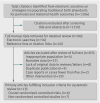Effectiveness of strategies incorporating training and support of traditional birth attendants on perinatal and maternal mortality: meta-analysis
- PMID: 22134967
- PMCID: PMC3228291
- DOI: 10.1136/bmj.d7102
Effectiveness of strategies incorporating training and support of traditional birth attendants on perinatal and maternal mortality: meta-analysis
Abstract
Objective: To assess the effectiveness of strategies incorporating training and support of traditional birth attendants on the outcomes of perinatal, neonatal, and maternal death in developing countries.
Design: Systematic review with meta-analysis.
Data sources: Medline, Embase, the Allied and Complementary Medicine database, British Nursing Index, Cochrane Library, Cumulative Index to Nursing and Allied Health Literature, BioMed Central, PsycINFO, Latin American and Caribbean Health Sciences Literature database, African Index Medicus, Web of Science, Reproductive Health Library, and Science Citation Index (from inception to April 2011), without language restrictions. Search terms were "birth attend*", "traditional midwife", "lay birth attendant", "dais", and "comadronas". Review methods We selected randomised and non-randomised controlled studies with outcomes of perinatal, neonatal, and maternal mortality. Two independent reviewers undertook data extraction. We pooled relative risks separately for the randomised and non-randomised controlled studies, using a random effects model.
Results: We identified six cluster randomised controlled trials (n=138 549) and seven non-randomised controlled studies (n=72 225) that investigated strategies incorporating training and support of traditional birth attendants. All six randomised controlled trials found a reduction in adverse perinatal outcomes; our meta-analysis showed significant reductions in perinatal death (relative risk 0.76, 95% confidence interval 0.64 to 0.88, P<0.001; number needed to treat 35, 24 to 70) and neonatal death (0.79, 0.69 to 0.88, P<0.001; 98, 66 to 170). Meta-analysis of the non-randomised studies also showed a significant reduction in perinatal mortality (0.70, 0.57 to 0.84, p<0.001; 48, 32 to 96) and neonatal mortality (0.61, 0.48 to 0.75, P<0.001; 96, 65 to 168). Six studies reported on maternal mortality and our meta-analysis showed a non-significant reduction (three randomised trials, relative risk 0.79, 0.53 to 1.05, P=0.12; three non-randomised studies, 0.80, 0.44 to 1.15, P=0.26).
Conclusion: Perinatal and neonatal deaths are significantly reduced with strategies incorporating training and support of traditional birth attendants.
Conflict of interest statement
Competing interests: All authors have completed the Unified Competing Interest form at
Figures





Comment in
-
Traditional birth attendants are an effective resource.BMJ. 2012 Jan 18;344:e365. doi: 10.1136/bmj.e365. BMJ. 2012. PMID: 22257977 No abstract available.
Similar articles
-
Traditional birth attendant training for improving health behaviours and pregnancy outcomes.Cochrane Database Syst Rev. 2012 Aug 15;2012(8):CD005460. doi: 10.1002/14651858.CD005460.pub3. Cochrane Database Syst Rev. 2012. PMID: 22895949 Free PMC article.
-
Treating periodontal disease for preventing adverse birth outcomes in pregnant women.Cochrane Database Syst Rev. 2017 Jun 12;6(6):CD005297. doi: 10.1002/14651858.CD005297.pub3. Cochrane Database Syst Rev. 2017. PMID: 28605006 Free PMC article.
-
Factors that influence the provision of intrapartum and postnatal care by skilled birth attendants in low- and middle-income countries: a qualitative evidence synthesis.Cochrane Database Syst Rev. 2017 Nov 17;11(11):CD011558. doi: 10.1002/14651858.CD011558.pub2. Cochrane Database Syst Rev. 2017. PMID: 29148566 Free PMC article.
-
Integrated management of childhood illness (IMCI) strategy for children under five.Cochrane Database Syst Rev. 2016 Jun 22;2016(6):CD010123. doi: 10.1002/14651858.CD010123.pub2. Cochrane Database Syst Rev. 2016. PMID: 27378094 Free PMC article.
-
Multiple-micronutrient supplementation for women during pregnancy.Cochrane Database Syst Rev. 2017 Apr 13;4(4):CD004905. doi: 10.1002/14651858.CD004905.pub5. Cochrane Database Syst Rev. 2017. Update in: Cochrane Database Syst Rev. 2019 Mar 14;3:CD004905. doi: 10.1002/14651858.CD004905.pub6. PMID: 28407219 Free PMC article. Updated.
Cited by
-
Community perceptions towards the new role of traditional birth attendants as birth companions and nutrition advocates in Kakamega County, Kenya.Matern Child Nutr. 2018 Feb;14 Suppl 1(Suppl 1):e12578. doi: 10.1111/mcn.12578. Matern Child Nutr. 2018. PMID: 29493900 Free PMC article.
-
An empirical evaluation of the impact scenario of pooling bodies of evidence from randomized controlled trials and cohort studies in medical research.BMC Med. 2022 Oct 24;20(1):355. doi: 10.1186/s12916-022-02559-y. BMC Med. 2022. PMID: 36274131 Free PMC article.
-
The role of traditional birth attendants and problem of integration with health facilities in remote rural community of West Omo Zone 2021: exploratory qualitative study.BMC Pregnancy Childbirth. 2022 May 20;22(1):425. doi: 10.1186/s12884-022-04753-5. BMC Pregnancy Childbirth. 2022. PMID: 35596165 Free PMC article.
-
Time for change is now: Experiences of participants in a community-based approach for iron and folic acid supplementation in a rural county in Kenya, a qualitative study.PLoS One. 2020 Jan 16;15(1):e0227332. doi: 10.1371/journal.pone.0227332. eCollection 2020. PLoS One. 2020. PMID: 31945073 Free PMC article.
-
Barriers to Institutional Childbirth in Rumbek North County, South Sudan: A Qualitative Study.PLoS One. 2016 Dec 15;11(12):e0168083. doi: 10.1371/journal.pone.0168083. eCollection 2016. PLoS One. 2016. PMID: 27977745 Free PMC article.
References
-
- World Health Organization. Trends in maternal mortality: 1990 to 2008 estimates developed by WHO, UNICEF, UNFPA and The World Bank. 2010. World Health Organization, 2010.
-
- World Health Organization. Millennium development goals report: 2007. United Nations Department of Economical and Social Affairs. United Nations, 2007.
-
- Brennan M. Training traditional birth attendants reduces maternal mortality and morbidity. Trop J Obstet Gynaecol 1988;1:44-7. - PubMed
-
- World Health Organization. Coverage of maternity care, a listing of available information. 4th ed. WHO, 1996.
Publication types
MeSH terms
LinkOut - more resources
Full Text Sources
Miscellaneous
